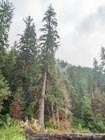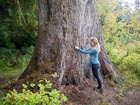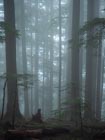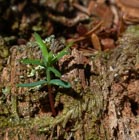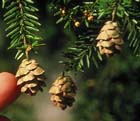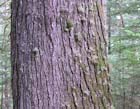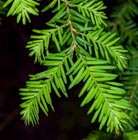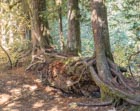Conservation Status

Tsuga heterophylla
(Raf.) Sarg. (1898)
Common names
Western hemlock, Alaska pine (Peattie 1950), pruche de l'ouest (Taylor 1993).
Taxonomic notes
Type not designated. There are 8 synonyms, see POWO; none are in common use. Molecular studies have conclusively placed this species sister to T. mertensiana in the clade of North American hemlocks (Havill et al. 2008, Holman et al. 2017, Feng et al. 2021); see Tsuga for further discussion. Reports of natural hybrids with T. mertensiana have not been substantiated; see T. mertensiana for details.
Description
Trees to 75 m tall and 200 cm dbh, with a narrowly conical crown that becomes irregular in old trees. Bark gray-brown, scaly and moderately fissured. Twigs yellow-brown, finely pubescent. Buds ovoid, gray-brown, 2.5-3.5 mm. Leaves (5-)10-20(-30) mm, spirally inserted but mostly appearing 2-ranked, flattened; abaxial surface glaucous with 2 broad, conspicuous stomatal bands, adaxial surface shiny green (yellow-green); margins minutely dentate. Seed cones ovoid, (1-)1.5-2.5(-3) × 1-2.5 cm; scales ovate, 8-15 × 6-10 mm, apex round to pointed. 2n=24 (Taylor 1993). Detailed information on pollen, including photomicrography, can be found in Davis (1999). See García Esteban et al. (2004) for a detailed characterization of the wood anatomy.
At the upper elevational limits of its distribution and under stressful conditions, T. heterophylla tends to resemble T. mertensiana, e.g., leaves are less strictly 2-ranked and stomatal bands on the abaxial leaf surfaces are less conspicuous than at lower elevations (Taylor 1993).
Distribution and Ecology
Canada: Alberta and British Columbia; USA: Alaska, Montana, Idaho, Washington, Oregon and California at 0-1830 m elevation in coastal to midmontane forests. It is a dominant species over much of its range (Taylor 1993). Hardy to Zone 6 (cold hardiness limit between -23.2°C and -17.8°C) (Bannister and Neuner 2001). See also Thompson et al. (1999).
Tsuga heterophylla is a dominant forest tree within its range. In low elevation coastal forests of Washington, Oregon and southern British Columbia, it shares dominance with Picea sitchensis, while in slightly drier environments from the western Cascade Range to its eastern range limits, its primary codominant is Pseudotsuga menziesii (Franklin and Dyrness 1988 and pers. obs.). Its role in western coastal forests reflects several factors. Conifers in general do well in the wet Pacific Northwest because their evergreen habit allows them to maintain positive net rates of photosynthesis during the long, wet winters; because many of them are very shade-tolerant, able to survive in a relatively dark understory until death of overstory trees allows them to continue their growth; and because the infrequency of stand-destroying disturbance is gives a competitive advantage to these long-lived trees (Waring and Franklin 1979). Tsuga heterophylla does particularly well in this region because the most common disturbance in the coastal temperate rainforest is windthrow, which may destroy single trees or, less commonly, may flatten whole forests across large swathes of the landscape. Tsuga heterophylla seedlings establish preferentially on organic substrates, especially wood. This gives hemlock a significant competitive advantage over Pseudotsuga and Thuja, both of which establish primarily on mineral substrates. Picea sitchensis shares the ability to readily establish on dead wood, so it is codominant with hemlock in coastal forests (Harmon and Franklin 1989).
Since 2015, the fungal pathogen Rhizoctonia butinii or "web rot" has increasingly been reported in death of westen hemlock within its native range. This appears to be a native pathogen that has become more prominent as hemlocks are increasingly stressed by summer drought and high temperatures, both of which are associated with anthropogenic climate change in the Pacific Northwest. The direct effects of drought stress have simultaneously become a widespread cause of hemlock death (Ramsey 2018, Haglund 2019). It seems likely that currently forecast climate change will lead to a progressive reduction in the range of western hemlock, with effects most pronounced in the southwestern portion of its range, where forecast moisture deficits would be greatest (Reilly et al. 2018).
Remarkable Specimens
The largest is 276 cm dbh, height 59.4 m, wood volume 87 m3, for a tree in the upper Wynoochee Valley, Olympic National Park, Washington (Van Pelt 2001). Van Pelt and I remeasured this tree in 2018 and it was approximately the same size, and still very healthy. The largest Canadian specimen is a tree with dbh 259 cm, height 55 m, and crown spread 20 m; it grows at Quisitis Point, Pacific Rim National Park, BC (Stoltmann 1987).
This is another one of those species (the others are Picea sitchensis and Pseudotsuga menziesii) where the tallest trees are just trying to keep up with even taller redwoods (Sequoia sempervirens) growing nearby. The tallest hemlock known, 83.34 m, was discovered in mid-November 2014 by Mario Vaden and Chris Atkins during explorations in Prairie Creek Redwoods State Park, California (Mario Vaden email 2014.11.23). Before that, the tallest known was "Tsunami", discovered on the day that the 2011 Japanese tsunami made landfall in nearby Crescent City, at 82.83 meters height; also discovered by Mario Vaden (Taylor 2011). Before that, the tallest known hemlock was 78.9 m tall, 140 cm dbh, also in Prairie Creek (R. Van Pelt e-mail 1998.03.18). I believe these trees are all still alive, suggesting that hidden out there somewhere in the redwoods are even taller hemlocks.
The oldest tree was found in the Caren Range (BC) by M.L. Parker; the sample has 1238 rings (R. Van Pelt e-mail 1998.03.18). The species is capable of establishing in the forest understory and surviving for very long periods (centuries) before entering the forest canopy. This ecological setting characterizes much of the lifespan of the oldest known individuals. Also, the oldest (and largest) specimens tend to be found near the upper elevation limits of the species, within subalpine forests. This may be an artifact of long-term climate change—it is thought that the Pacific Northwest mountains were slightly warmer and drier during the 'Medieval Optimum' of ca. 1100-1250 AD, so optimum growth rates were attainable at higher elevations—or it may reflect reduced susceptibility to disease caused by low annual temperatures and mixed-species stand composition.
Ethnobotany
The bark has a high tannin content. Native peoples used it as a tanning agent, pigment and cleansing solution. The Quileute, for example, used a hemlock bark extract for tanning hides and soaking spruce-root baskets to make them watertight. Some Coast Salish people used a red dye made from hemlock bark to color mountain goat wool and basket materials, and as a facial cosmetic and hair remover. Various tribes would use the bark to dye fish nets brown, making them invisible to fish. Black and yellow-orange dyes were also derived from the bark. The wood is moderately heavy and fairly easy to carve. It was carved into implements such as spoons, combs and wedges. The Haida made large feast bowls from the wood of bent hemlock trunks. The branches were considered an excellent bedding material, and were also used to collect herring spawn by placing them in estuaries where the herring would use them as a spawning substrate. The pitch and the outer and inner bark were widely used medicinally (Pojar and Mackinnon 1994).
Tsuga heterophylla is the most economically important timber hemlock. The wood is superior to that of other hemlocks for building purposes and is most often used for studs and plywood (sold under the "hemfir" designation) and laminated beams; it also makes excellent pulp for paper production. Due to uniform grain and consistent density, it mills, planes and shapes well. Decay resistance is low (MacSween n.d.). Large portions of the Washington and Oregon Coast Ranges, and the Olympic Peninsula of Washington, are managed primarily for Tsuga heterophylla production. It has also been planted for forestry in NW Europe, primarily Britain and Ireland, a use that peaked in the mid-20th century and is now in disfavor. It is locally naturalised in Britain, with dense regeneration in several forests (Harmer et al. 2011). It is also used as an ornamental (USDA hardiness zones 5, inland populations, to 7, coastal populations).
The species has been widely used in dendrochronology. About half of the studies have dealt with forest ecological problems including primary succession, fire history and tree population dynamics, but there have also been studies of culturally modified trees, the effect of volcanic eruptions, the effect of smelter emissions, wood technology and even forensic uses. Because the species typically grows in a forest interior environment, ring width variation is typically determined primarily by the tree's competitive status. Thus, it is an excellent species for studies of forest structural change during development of late-successional forests. However, because the wood decays rapidly after tree death, most dating studies must rely exclusively on inference from living trees.
Observations
The species can be readily found in its range from BC to CA. Outstanding examples can be found throughout the lowlands of Olympic National Park in WA and at Pacific Rim National Park on Vancouver Island, BC.
Remarks
Western hemlock is the state tree of Washington (Taylor 1993).
This species was first described by Meriwether Lewis on February 5, 1806 while encamped at Fort Clatsop near the site of modern Astoria. Lewis readily distinguished it from the eastern hemlock Tsuga canadensis (though at the time both were regarded as firs). Lewis never published his notes, though, and it remained for Constantine Rafinesque, a French polymath living in Ohio, to describe this tree in 1817. He did not publish that work, however, and it was 1832 when Rafinesque finally published his description of the species. (Notably, David Douglas had seen and noted it in 1828, but thought it the same species as the eastern hemlock.) Finally, Sargent in 1898 correctly identified it as a species of Tsuga, a genus recognized since 1855. Rafinesque chose the epithet heterophylla for this plant because of the great variation in leaf sizes he saw on the specimens collected by Lewis and Clark (Reveal n.d.).
Citations
American Forests 1996. The 1996-1997 National Register of Big Trees. Washington, DC: American Forests.
Davis, Owen K. 1999. Pollen Grain Morphology Hemlock. http://geo.arizona.edu/palynology/pid00012.html, accessed 2000.02.06, now defunct.
Feng, Yuan-Yuan, Ting-Ting Shen, Cheng-Cheng Shao, Hong Du, Jin-Hua Ran, and Xiao-Quan Wang. 2021. Phylotranscriptomics reveals the complex evolutionary and biogeographic history of the genus Tsuga with an east Asian-North American disjunct distribution. Molecular Phylogenetics and Evolution 157:107066. https://doi.org/10.1016/j.ympev.2020.107066.
Haglund, Noah. 2019. Blight ravages the western hemlock, Washington’s state tree. https://www.heraldnet.com/news/blight-ravages-the-western-hemlock-washingtons-state-tree/, accessed 2020.10.31.
Harmer, Ralph, Kate Beauchamp, and Geoff Morgan. 2011. Natural regeneration in western hemlock plantations on ancient woodland sites. U.K. Forestry Commission Research Note FCRN011.
Harmon, M. E. and Jerry F. Franklin. 1989. Tree seedlings on logs in Picea-Tsuga forests of Oregon and Washington. Ecology 70(1):48-59.
Havill, Nathan P., Christopher S. Campbell, Thomas F. Vining, Ben LePage, Randall J. Bayer, and Michael J. Donoghue. 2008. Phylogeny and biogeography of Tsuga (Pinaceae) inferred from nuclear ribosomal ITS and chloroplast DNA sequence data. Systematic Botany 33(3):478–489.
Holman, G., P. Del Tredici, N. Havill, N. S. Lee, R. Cronn, K. Cushman, S. Mathews, L. Raubeson, and C. S. Campbell. 2017. A new species and introgression in eastern Asian hemlocks (Pinaceae: Tsuga). Systematic Botany. 42(4):733–746.
MacSween, Peter. [no date]. Woods to know: Hemlock (western). https://www.canadianwoodworking.com/woods-know-hemlock-western, accessed 2020.10.31.
Rafinesque, C. S. 1832. Six new firs of Oregon. Atlantic Journal 1:119–120. Available: Biodiversity Heritage Library, accessed 2024.11.16.
Ramsey, Amy C. 2018. Forest Health Update: Emerging Issues with Western Hemlock and Douglas-fir. https://sflonews.wordpress.com/2018/06/19/forest-health-update-emerging-issues-with-western-hemlock-and-douglas-fir/, accessed 2020.10.31.
Reilly, Matthew J., Thomas A. Spies, Jeremy Littell, Ramona Butz, and John Kim. 2018. Climate, Disturbance, and Vulnerability to Vegetation Change in the Northwest Forest Plan Area. V.1, Pp.29-93 in T. A. Spies, P. A. Stine, R. Gravenmier, J. W. Long, and M. J. Reilly, tech. coords., Synthesis of science to inform land management within the Northwest Forest Plan area. Gen. Tech. Rep. PNW-GTR-966. Portland, OR: USFS Pacific Northwest Research Station.
Reveal, James R. [no date.] Rafinesque's six firs. Discover Lewis & Clark, accessed 2024.11.15.
Sargent, C. S. 1898. The silva of North America, V. 12, p. 73. Boston: Houghton Mifflin. Available: Biodiversity Heritage Library, accessed 2025.02.19.
Taylor, Michael. 2011. Winter 2011 Latest News. www.landmarktrees.net, accessed 2011.03.18.
Van Pelt, Robert. 2001. Forest Giants of North America. Seattle: University of Washington Press.
This page edited with the help of M. P. Frankis, 1999.02.
See also
British Columbia Ministry of Forests. 1996. Tree Book: Learning to Recognize Trees of British Columbia. http://www.for.gov.bc.ca/PAB/EDUCATE/TREEBOOK/tree-toc.htm, accessed 2000.02.06, now defunct.
Burns and Honkala (1990).
Elwes and Henry 1906-1913 at the Biodiversity Heritage Library (as T. albertiana) (Photo). This series of volumes, privately printed, provides some of the most engaging descriptions of conifers ever published. Although they only treat species cultivated in the U.K. and Ireland, and the taxonomy is a bit dated, still these accounts are thorough, treating such topics as species description, range, varieties, exceptionally old or tall specimens, remarkable trees, and cultivation. Despite being over a century old, they are generally accurate, and are illustrated with some remarkable photographs and lithographs.
MacKinnon et al. (1992).
Sargent (1898) provides an exceptionally detailed description of this species, with an excellent illustration.

